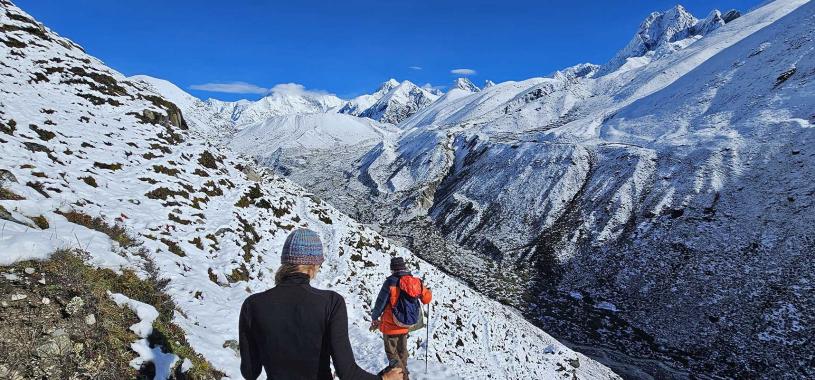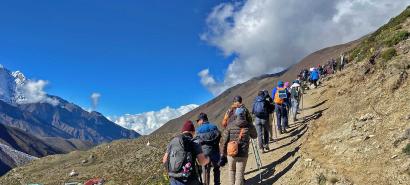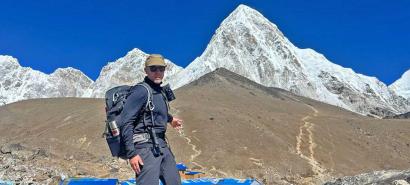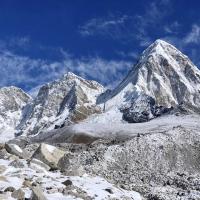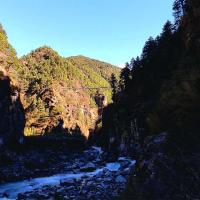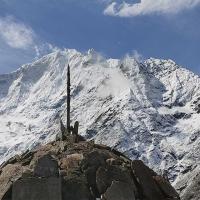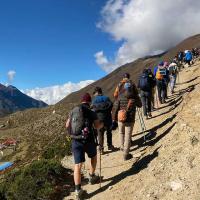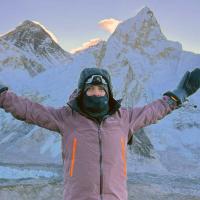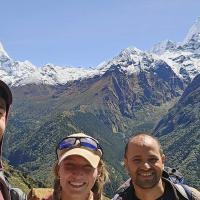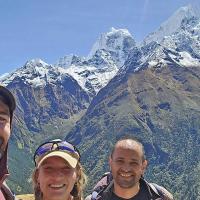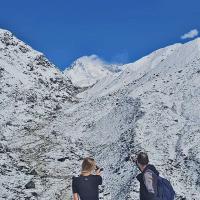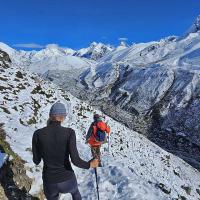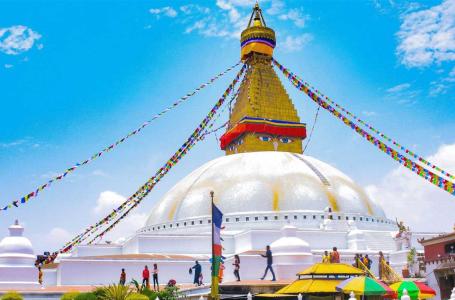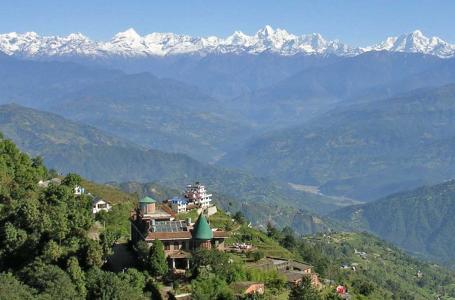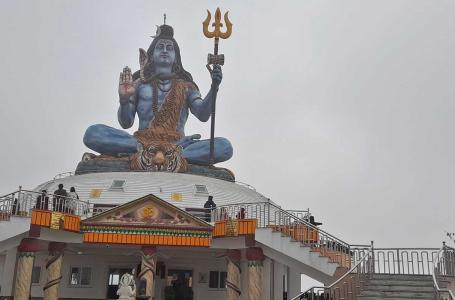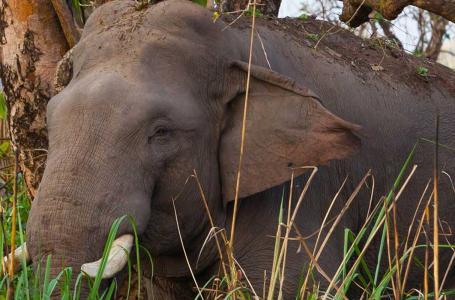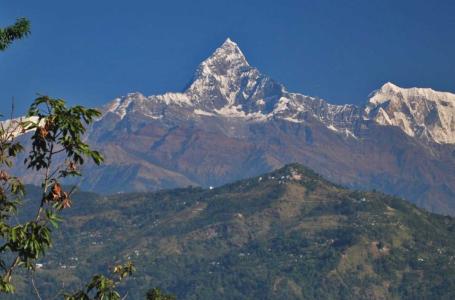- 01 Pax USD 2045 pp
- 02 to 5 Pax USD 1945 pp
- 06 to 10 Pax USD 1845 pp
- 11 to 15 Pax USD 1745 pp
Itinerary
In the peak season, there is a flight available from Ramechhap to Lukla. The journey from Kathmandu to Ramechhap takes approximately 5 hours by road, where you will need to catch a bus from Thamel around 1.30am. You will reach at Ramechhap airport around 6.30am and then proceed to wait for your flight to Lukla. However, during off-peak times, you have the option to fly directly from Kathmandu airport to Lukla.
Catch a scenic flight to Lukla, early in the morning, from the airport at Kathmandu (TIA). As your plane takes off, it flies over the rewarding valleys of undulating hills and ridges that look just like a typical Chinese bowl. A few distances ahead, there lies a random chain of unparalleled mountains, glittering beyond its aptitude. It is a wow-inspiring vista.
Upon landing, we will have a tea at Lukla and then, hit on the trail to Phakding. The path goes along the quaint settlements of Chopulu and crosses several suspension bridges, tangled by the colorful prayer flags. Before arriving at the Ghat, the next village, a dream-like view of the Kusum Kanguru peak inspires us to press on with rest of the journey to Phakding. It is a wonderful walk.
From Phakding, the trek to Namche can be taxing in some measure because of the effects of the altitude. So, to avoid any problematic situation, it is better to walk slowly with controlled breathing.
First, the trail contours around the west side of the Dudh Koshi River and crosses a suspension bridge to keep ourselves west of the river. The views are blocked by a tall hill, spanning in a north-south direction. But, as we arrive at Tal, a beautiful waterfall gives us a consolation reward. Soon, another waterfall waits at the village of Bengkar, which is also famous for its good apple pies.
We will continue to the sensational forest of Sagarmatha National Park and check our permits at Monjo. The walk is very much pleasant through the wilds of the mountains and bestows us with a cheering glimpse of the Mt. Everest, the legend of the world.
A beautiful Kani Gate welcomes us to the village of Namche.
Namche has a long trading history. The ancient trading routes crisscross the village and linked the Tibet with Nepal in the past. The primary import was salt, exchanged for other commodities. These historical moments are captured in the museum of Namche. Also, there are wonderful viewpoints to join and enjoy the natural scenery.
From Namche, there are two options for a side-trip. While Thame is the option for mountain lovers, the one who loves to witness the classic culture of Sherpas can go to the village of Khumjung and Khunde. There is also a Hillary hospital at Khunde, founded by Sir Edmund Hillary in 1966. It is a nice walk.
All these fantastic places make Namche an ideal spot for acclimatization.
After proper acclimatization, the walk to Tengboche becomes an easy one. We will go through a picturesque Tenzing Norgay Memorial Stupa. There is a viewpoint, peering at the first views of Ama Dablam, Lhotse Shar, Taboche, Kangtega, and Thamserku peaks. It is incredible.
While continuing the journey, you will see a beautiful chain of 7 water-driven prayer wheels, spinning by the pace of the river, before a suspension bridge. This bridge shows us the path ahead to the Tengboche through the quaint pastures, used by yaks for grazing.
Don’t miss out a visit to the Tengboche Monastery as it is artistically delicate and architecturally superior. It is the largest monastery of the Everest Region (Khumbu Region) and paintings of the interior of the monastery are worthy of every diamond on the planet.
A trek to Dingboche is one of the most gratifying days of the overall trekking in the Everest region as you will encounter some of the unusual views of the Himalayas that only a few have witnessed it in other mountainous regions. While trekking to the Dingboche, become aware of the possible altitude effects and walk slowly.
For a while, the walk is quite disappointing with no better views of the mountains. But, as you cross a bridge to be on the west side of the river, the whole prospect of the mountains becomes visible. It is when you realize how fascinating the mountains are and why people crave for trekking in the Everest region? You will meet some of the unexpected valleys and gorgeous rivers before entering into the Dingboche.
A village of Dingboche looks like a typical stone village where the stone walls and stone houses are ubiquitous. These walls are built around the farm fields and the houses to protect them from the heavy winds. People are smiley and speak Sherpa Language. It is a pleasant village.
A trek to Chhukung is not as hard as one might expect, but the real challenge comes when you hike to the Chhukung Ri.
Chhukung Ri, at an altitude of 5,550 m, poses greater risks of the altitude sickness. However, the reminiscing views of the Makalu, Lhotse Shar, Pumori, and Cho Oyu are simply magical. Nothing is as pure and untouched as these mountains are. On a clear day, the icy walls of Baruntse add further charm to the scenery.
Later, after spending quality time on top of the Chhukung Ri, we will descend to the Chhukung for the night stay.
From Chhukung, we will head up north, along the steep trails, to climb the Kongma La pass, the highest pass of the three passes in the Everest region. The trails are well defined for the most part, but as you approach the pass, the rocky inclination begins. The views of the lower mountain valleys start to show up once you are halfway along the pass. A steep ascent leads you to the top of Kong ma La pass presenting a unique variety of possible combinations of icy lakes, glaciers, and the mountains.
The glacier walls of Nuptse and Lhotse are truly mesmerizing. The high peaks of Makalu and Island peak are also clearly visible. What’s more intriguing is the view of the rising giant, Mt. Everest, dazzling in the sunlight. Eastern flank of Kong ma La is guarded by the undefeatable slope of ice. It is one of the perfect spots to witness the terrific icy creations of the world.
After crossing the pass, we will head down to the Lobuche, enjoying the views of the Khumbu glacier. The descent should be slow and careful to acclimatize. Once we arrive at Lobuche, the peak of Nuptse appears rewarding on a clear day.
From Lobuche, the path goes along the ridge and crosses several ups and downs to finally arrive at the Gorakshep. The views of the snowy pyramids, on the west, are worth seeing on the way. We will stay to Gorakshep for the overnight stay. We will hike to the Everest Base Camp. At a glance, the base camp is a vast snowscape with the views of the mountains covered by the thick haze. But the feeling of being on top of the world is enough to rank Everest Base Camp as one of the best destinations in the world. At base camp, you will see some of the climbers preparing for their ascent to the Everest’s top. The views are interesting to see from the Everest base camp.
We will, then, descend back to the Gorakshep.
From Gorakshep, we will catch a side trip to a wonderful viewpoint of Kalapatthar. While many people attempt this hike in the next day morning, we will hike in the afternoon because the sunset views from the Kalapatthar are far better than the sunrise views. The southern black face of the Everest and countless dotted ranges make this viewpoint one of the most beautiful viewpoints of the world.From Gorakshep, we will catch a side trip to a wonderful viewpoint of Kalapatthar. While many people attempt this hike in the next day morning, we will hike in the afternoon because the sunset views from the Kalapatthar are far better than the sunrise views. The southern black face of the Everest and countless dotted ranges make this viewpoint one of the most beautiful viewpoints of the world.
Return to Gorakshep for a hot breakfast. Then, begin your descent along a less-traveled route toward Dzongla, a peaceful village nestled beneath Cho La Pass. The trail is quieter and features incredible backdrops of Taboche and Cholatse. Arrive by late afternoon, tired but content, and ready for the second pass tomorrow.
Another demanding but unforgettable day awaits. Start early to tackle Cho La Pass, a steep and icy climb that often involves crossing snowfields and a small glacier. Yak tracks and cairns guide the way up to the pass, where prayer flags flutter in the wind against the backdrop of sparkling peaks.
The descent is slippery and requires careful footing over rocks and scree, leading to Thagnak.
From Thaknag, we will walk along the steep icy path across the Ngozumpa glacier, the longest glacier of Nepal, to arrive at the Gokyo. On this day itself, we will pay a visit to the Gokyo Lakes System, the world’s highest freshwater lake system consisting of the six major lakes. The turquoise blue water of these lakes invigorates the soul with a sense of warmth and pleasure. Religiously, this lake system is considered to be the abodes of snake gods and in every Janai Purnima, Hindu’s festival that falls in the month of August, the pilgrimages come to dive into the pristine cold water of Gokyo. It is a surreal experience to explore the Gokyo lakes system.
Gokyo Ri is the Kalapatthar of the Gokyo region. The views of the breathtaking Gyangchung Kang and Cho Oyu are so sensational that it triggers all your six senses, including the mind, simultaneously. To arrive at this viewpoint, however, is not easy. The path is pretty steep and icy, so consider the dangers of ascending prior to joining the trail. Walk slowly and breathe regularly as it helps in the acclimatization of the body. Once you are on top, the views are all yours. Some people believe that the views from the Gokyo Ri are better than that from the Kalapatthar as well. Later, we will descend back to Gokyo.
You can choose today or tomorrow .
A well-deserved rest day, but with an optional hike to Gokyo Ri, a 2–3 hour ascent offering arguably the finest panoramic view in the Everest region. From the summit, you’ll witness a breathtaking 360-degree vista of Everest, Lhotse, Makalu, and Cho Oyu, along with the sprawling Ngozumpa Glacier and five sacred lakes below.
If you prefer a more relaxing day, explore the village, visit the higher lakes (Fourth and Fifth Gokyo Lakes), or simply relax by the shore, soaking in the peace and beauty of this magical valley. Tonight’s dinner is accompanied by stories and laughter from fellow trekkers who’ve shared similar paths.You can Choose if yu want to hike gokyo ri todat or the day before .
A trek to Lungden from Gokyo is, indeed, a big day as you are about to cross the last pass of the Everest Region- Renjo La pass. This pass is the only one that can be crossed by the yaks. Despite that, the final ascent can be really taxing for any avid trekkers to complete. The trail is steep and sometimes goes flat, but even the flat sections are equally difficult to climb because of the altitude. Once you rise to the top of the pass, the glittering panorama of Everest and Makalu are breathtaking. The whole view appears dramatic and can be ranked 5/5 for its design and aesthetic appeal.
The descent to Lungden is also very hard. The icy terrain and the stone stairs put more pressure on the knees, so ascend slowly and calmly. Once you are on Lungden, the faraway views of the Himalayas can still be enjoyed.
From Lungden, the trail descends down the valley and crosses a Langmuche Khola. The path is well-trodden and is full of amazing views- not just of mountains but also of the river valleys and the gorges. We will go parallel to the Bhotekoshi River until we make an appearance at Thame, our next destination. Thame is a classic Sherpa hamlet, which is rarely visited by the trekkers of the Everest Base Camp. The Tenzing Norgay Sherpa is said to have born in this Thame.
From Thame, Namche is not very far. It can be reached within a short time and the rest of the time could be used to explore the markets and hamlets of the Namche. If you hadn’t been able to explore the museums and Namche Monastery, then you should not miss that on this day. The museum displays the historic arts of the Namche, the climbing gears of the first Everest summiteers, and many other classic monuments. Similarly, the monastery is a peaceful hub to sit and enjoy nature.
From Lungden, the trail descends down the valley and crosses a Langmuche Khola. The path is well-trodden and is full of amazing views- not just of mountains but also of the river valleys and the gorges. We will go parallel to the Bhotekoshi River until we make an appearance at Thame, our next destination. Thame is a classic Sherpa hamlet, which is rarely visited by the trekkers of the Everest Base Camp. The Tenzing Norgay Sherpa is said to have born in this Thame.
From Thame, Namche is not very far. It can be reached within a short time and the rest of the time could be used to explore the markets and hamlets of the Namche. If you hadn’t been able to explore the museums and Namche Monastery, then you should not miss that on this day. The museum displays the historic arts of the Namche, the climbing gears of the first Everest summiteers, and many other classic monuments. Similarly, the monastery is a peaceful hub to sit and enjoy nature.
Namche to Lukla is the same trail that we have been earlier. The trail is descending but a long walk makes it tiresome. When you reach Lukla, take your time out to explore the region.
Flight to Kathmandu is the return flight. Make sure you are aware of the flight confirmations. Enjoy the scenery from the windows of your airplane.
Lukla to Manthali Airport in a plane (15min) and Drive to Kathmandu (131km):5/6 hours drive in Car/Jeep
In the peak seasons of Autumn (September to November) and Spring (March to May), there is no direct flight between Kathmandu -Lukla and Lukla - Kathmandu). therefore we have to take a alternative route through Kathmandu- Ramechhap- Lukla and Lukla- Ramechha- Kathmandu. the distance between Kathmandu to Ramechhap 131km, takes 5/6 hours in a car/Jeep and 15min flying to Lukla and same way back to Kathmandu from Lukla at the end part of the trip.
Overview
Everest Three Passes Trek is an ideal way to challenge yourself mentally and physically, alongside rewarding your soul with some of the spectacular views of the Himalayas. In this trek, the trekkers will circuit around the Everest region through three incredible High Passes-Kongma La Pass (5,535 m), Cho La Pass (5,470 m), and Renjo La Pass(5,360 m). Out of these passes, Renjo La is the only one that can be crossed by the yaks but this doesn’t mean that this pass is less taxing and you can easily go through it.
The challenges of the passes equally reward you with the complex views of the mountains, glaciers, and lakes. From the mighty Everest to the incredible Makalu, nothing can be long hidden from these prodigious high passes. Plus, you will visit the Everest Base Camp, Gokyo Lakes System, Kalapatthar, and Gokyo Ri to inspect the Himalayas from different angles. Everest High Pass is the best way to fully explore the Everest Region.
Planning the Everest 3 Passes Trek:
The Everest Three Passes Trek is difficult in Nepal's Everest area. Assess your fitness level and secure the relevant licenses and travel insurance before going on this tour. Choose the proper season, usually spring or fall, and carry suitable clothes and equipment for changing weather conditions. Plan a 16-18-day plan that includes acclimatization days, and consider hiring native guides and porters. Make appropriate acclimatization a priority, remain hydrated, and train for high altitudes. Respect the environment and local culture, budget sensibly, and plan your trip to Lukla. Finally, double-check all permissions and equipment before embarking on this thrilling adventure.
The best time to do the Everest Three Pass Trek?
The fall seasons (September to November) are ideal for undertaking the Everest Three Pass Trek. We can climb more easily because it's warm outside and your boots' traction on the snowy tracks may hold. Additionally, during these months, you can look for a group (or any trekker) to go on the Everest Three Pass Trek with you.
Trekking is also nice in the spring months of March, April, and May, but avalanches are possible.
Summer (June, July, and August) and monsoon season are not ideal times to complete the Everest Three Pass Trek. Additionally, a regular hiker might find the winter's cold (December, January, and February) intolerable.
Foods and Accommodations during Three Pass Trek:
Travellers may anticipate staying in teahouses while on the Everest Three Passes Trek, which provides both lodging and food. To ensure that trekkers have nutritional meals to sustain their energy, these teahouses provide a variety of culinary options, including Nepali delicacies and international cuisine. Even though the quality of the meal varies, it is usually satisfying and substantial.
Avoid eating fresh salads and vegetables if you want to stay healthy. Teahouses offer simple yet pleasant lodging in twin-sharing rooms furnished with plain mattresses and blankets. The warm, comfortable rooms keep you warm on frigid evenings. Public restrooms are typical, and hot showers can be had at an additional cost.
It is advisable to speak with your tour guide about the cuisine for much better and healthier options.
Transportation: Everest High Passes:
Because there is no direct connection from Kathmandu to Lukla, travellers have to travel for four hours (shared Hiace Van journey) from Kathmandu to Manthali Airport. This is due to heavy traffic at Kathmandu's international airport (Oct-Nov and March-Apr).
We will then take a direct flight from Rameechap Manthali Airport to Lukla Airport. If you want to travel by private vehicle, an additional cost of USD 100 must be paid. In terms of flight time, Travellers should plan to check out at about 1 a.m. for the same-day flight.
If you opt to remain one night in Rameechap for the same-day flight, you will be charged an additional amount for the hotel, which will be approximately USD 20 per person.
Necessary Permits & TIMS: Trekking in Everest:
To visit the territory, Everest requires three sorts of permits. A Trekker's Information Management System (TIMS) Card is no longer required. These permissions can only be obtained from licensed agencies, and no freelancing guide can give them.
Khumbu Pasang Lhamu Rural Municipality Entrance Permit:
This permit is intended to supervise and handle tourism activity in the Khumbu region. It is necessary across the Khumbu region, including Namche Bazaar, Tengboche, Dingboche, and Gorakshep, and is valid till Jiri.
Cost: NPR 3000 Per Person for each foreigner.
Sagarmatha National Park Entry Permit:
The purpose of this permit is to restrict and manage entry to the Sagarmatha National Park to preserve its natural beauty and biodiversity. The cash collected by these permits is utilized to conserve and maintain the park.
Cost: NPR 3000 Per Person for each Foreigner
Additional Permit for Jiri to Everest Base Camp Trek:
While entering Everest via Jiri, an extra permit for the Gaurishankar Conservation Area is required till we reach the Everest Base Camp Trek.
Cost: NPR 3000 Per Person for each foreigner.
(All the permits required are included in this package).
Necessary documents for Permits:
You will only need your valid passport photocopy (validity of 6 months).
Highlights
- A magnificent flight to Lukla.
- View of the three high passes (Kongma La, Cho La, and Renjo La).
- Breathtaking Vistas from Gokyo Ri.
- Gokyo Lakes.
- Ancient monastery in Tengboche.
- Nepal’s biggest Khumbu and longest Ngozumpa glaciers
- Three great high passes (Kongma-La, Cho-La & Renjo-La pass)
- Hillary Museum
- Sagarmatha National Park
- Traditional Sherpa villages, culture, traditions & hospitality
Cost Details
- Airport pickup and drop service.
- Accommodations in Kathmandu 2nigh.
- All food and accommodation during the trek.
- Transportation costs: Comfortable drive from hotel to airport to hotel.
- Flight ticket kathmandu to Lukla to kathmandu.
- License Holder English speaking trekking guide.
- Guide salary, lodging, food and insurance.
- Trekking permits: Sagarmatha National Park Area fees.
- First aid medical box.
- T-shirt, Duffel Bag and Trekking Map.
- Rescue Management Service.
- All Tax 13% VAT+10% Service charge.
- Farewell Dinners
- All kinds of Drinks.
- Visa fee to enter Nepal.
- International flight tickets and extra baggage charges
- Extra night accommodation and meal costs in Kathmandu due to any change in the scheduled itinerary
- Porter.(1 porter for 2 trekkers with a max load of 17 to 20kg).
- Travel insurance/ Rescue operation costs.
- All personal expenses (laundry, electronic device. charging cost)
- All required trekking gears like sleeping bags and down jacket made available on rent.
- Tip for guide and porters.
- Hot and cold Shower.
Dates & Pricing
Trip Start and End Point
Kathmandu / Kathmandu
| DATES | STATUS | PRICE | SPACE LEFT | ||||
|---|---|---|---|---|---|---|---|
|
Start date: 21-Dec, 2025
End date: 05-Jan, 2026 |
Guaranteed | USD 2045 |
2
|
Book Now | |||
Equipment List
- Woolen shirts and thick sweaters.
- Jackets (Fiber or down).
- Waterproof jacket with hood or poncho.
- Tracksuit, Track shoes and Trousers.
- Thermal Underwear and Thermal coat.
- 2pair of loose fitting long shorts/ skirts.
- Pair of Gloves and sandals.
- Woolen hat and Long sleeved shirt.
- Light weight walking boots.
- 2pairs of thin socks and 2 pair of woolen socks & neck gaiter.
- Snow glasses and sunglasses.
- Trekking Sticks and Duffle bag or kit bag to carry to gear while trekking.
- Some (small/large) plastic bags to separate clean clothes from dirty ones and some smaller plastic bags to dispose garbage.
- Daypack bag to carry your personal requirements.
- Water Bottle, water purifying tablets.
- Towels, Umbrella (optional).
- Head lamp, Binocular, Camera, trekking map and compass, reading materials, pencil, rubber, pen, notebook & moisturiser for lip, face body.
Travellers Review
Exceptional Three Passes Trek Experience with Trek Mania
We did the Three Passes trek this September and booked through Trek Mania. With so many companies to choose from, it’s hard to know which one will be best, but we’re glad we made the right choice! The owner was incredibly friendly and ensured we were well taken care of from the moment we arrived in Kathmandu. The guide he arranged for us, Hem, was outstanding—kind, knowledgeable, and always looking out for us. When we encountered bad weather, Hem truly shined, expertly guiding us to safety. We honestly don’t know what we would have done without him. Along the way, we also learned so much about the surrounding landscape and local culture. Trek Mania made sure everything was organized, so all we had to do was focus on enjoying the hike, which was exactly what we wanted. Highly recommend!
Best guide ever
I had an amazing experience ! Pralad is a great guide, always making sure we travel safe, checking every meal and accomodation, and his first concern is that we live the best experience, have a happy journey and keep positiveness in our mind. It was really intereresting to talk with him, we had a lot of fun and nice moments. The landscapes are wonderful, going through nice villages, sunny peaks, jungle and foggy moutains There is so much more than the walk, we braught back his optimism at home, along with beautiful memories. Will sure come back if I can !
Best guide ever
I had an amazing experience ! Pralad is a great guide, always making sure we travel safe, checking every meal and accomodation, and his first concern is that we live the best experience, have a happy journey and keep positiveness in our mind. It was really intereresting to talk with him, we had a lot of fun and nice moments. The landscapes are wonderful, going through nice villages, sunny peaks, jungle and foggy moutains There is so much more than the walk, we braught back his optimism at home, along with beautiful memories. Will sure come back if I can !


